Book Reviews
 |
 |
 |
 |
 |
 |
 |
The Androgynous Christ & Adam
Book-review of Fumus Satanae (The Smoke of Satan) by Atila Sinke Guimarães, Volume 8 of the Collection Eli, Eli, Lamma Sabacthani?, TIA: Los Angeles, 2015, 398 pp.
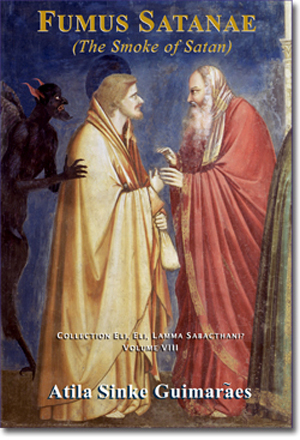
Purchase here
From Volume VII, Destructio Dei, we already learned that this doctrine invented by Progressivism is completely different from the serene teaching of Catholic Church on the Holy Trinity. Yet it is a system developed by some of the most important theologians of the conciliar era – Teilhard de Chardin, Karl Rahner and Hans Urs von Balthasar. Of these three, Guimarães chooses Von Balthasar's extensive teaching as the most comprehensive and “coherent” – if a confused, inherently disjointed schema can be called coherent (Chap. VI § 52). Thus, he concentrates on exposing the errors in von Balthasar's many works.
There are three spheres where this drama unfolds, a divine sphere where a curious irregular godhead unfolds: a masculine Father, a feminine Son and a Spirit that acts as a kind of carnal link between the two.
The second sphere is an eternal sphere, where the progressivists place their “Jerusalem that is above” (Gal 4:26). Here everything becomes more befuddling. On this plane we have a supposed ”original sin,” an “eternal Christ” who precedes the historical Christ, and a “holy Church” – as well as a “sinner Church,” which is cast out of the eternal sphere into the third sphere.
This one, of course, is the created sphere, which exists and develops its history in an evolutionary process based on what happens in the eternal sphere. The earthly historical Christ, for example, is just a reflection of the eternal Christ; everything that happens in the earthly Church is just a reflection of what happens in the eternal Jerusalem etc.
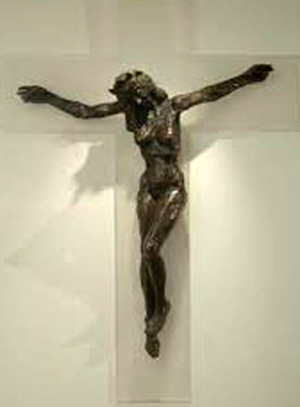
Some progressivist art even portrays Christ as feminine, following this new Trinitarian doctrine
What Guimarães exposes in a brilliant way is that there was a lot of borrowing going on in the invention of the progressivist Trinitarian doctrine. For example, the notion of an initial feminine element in the Divinity, as well as a first man and eternal Christ who is both masculine and feminine, are ideas embedded in both the Jewish Kabbalah and Gnostic doctrine. So, the roots of the “new” progressivist Trinitarian doctrine are both gnostic and Jewish, the latter of which borrows, in its turn, significantly from the former.
All this is set out in Chapter VII, which shows the affinities among the progressivist Trinitarian doctrine, Gnosis and the Jewish Kabbalah. The chapter was a fascinating read for me, as it will be for those interested in better understanding the underpinnings of the occult thinking and how it has entered the New Theology of Vatican II.
The androgynous Christ
Here I will look briefly only at several characters who play roles in the progressivist dramaturgy: the Androgynous Christ, which leads on its twisted road to a parallel androgynous first man, Adam Kadmon.
This topic is of particular interest today because everywhere we see statues in progressivist art of a Christ with androgynous features. At the same time we find a strange tolerance in the Conciliar Church for homosexuals and transgenders. For example, homosexuals applauded Pope Francis after he met and hugged a transgender Spanish “woman-man” at the Vatican and told her/him that the "Church loves and accepts you as you are."
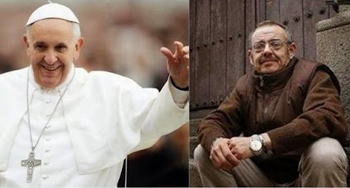
Francis welcomes a transgender person and tells her/him there is a place in the Church for her/him
As Guimarães shows in Chapter I when he introduces his first character onstage, the Eternal Feminine, the progressivists envision a feminine element in the Divinity itself in the person of Christ. For von Balthasar and de Lubac, the Word or Second Person would actually be the Divine Feminine, which attracts in a “carnal way” the Father (Chap I §§ 54, 98). This is why the conciliar Popes and theologians say that God is both our Father and out Mother (Chap. I §§ 41-50).
Incidentally, this notion of the feminine inside God is also in the Kabbalah (Chap. VII § 86), where the sexual law is the principal mark and governs everything (Chap. VII §§ 93, 130).
The second character Guimarães introduces is the Androgynous Christ, who is "conceived as a protagonist who would unite in himself the masculine and feminine sexes. At times he would be a wife in relation to the Father, at times a husband in relation to the Church. It is this singular androgynous Christ who plays a central role in the pro¬gressivist Trinitarian procession" (Chap. II, § 1).
The many doctrinal eccentricities in these notions are examined by the author. What is shocking – for the author and for us – is the clear adoption of carnal copulation as the matrix of the relationships of the Divine Persons among themselves and with the Church. Again, we find in the underpinnings of this thinking the omnipresent sexual law of Jewish mysticism.
The androgynous first man
Based upon this divine background the progressivists naturally apply the same androgynous character to the first man, Adam. For if the masculine and feminine elements are present in the Divinity itself, as well as in the person of Christ, would they not be present also in each human person?
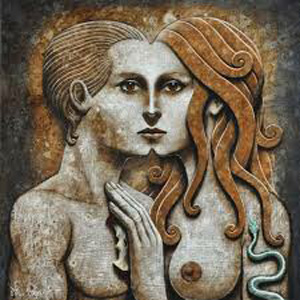
An androgynous Adam, broken into two sexes by sin, must be restored through the sexual act
But there is more. Following this thinking to its consequences, the ideal humanity would be androgynous, as it existed in Adam before his "fall."
This thesis that the first man integrated male and female in himself is what John Paul II defends in his "Theology of the Body," which Guimarães aptly analyzes in Chapter V. Thus, the initial stage of perfection in man was androgynous and, since it was lost by sin, there is an imperative need to restore the "unity of the two" by means of the "nuptial relationship between man and woman" (Chap. V, § 198). Again, we find the matrix of the relationship is the sexual act.
This chapter is the first straightforward and coherent reading I have seen of JPII's strange theology, and alone is worth the price of the book. Guimarães shows how JPII points to individualism as the original sin, causing the initial "man to rupture into man and woman, with the dominion of man over woman" (Chap. V § 79).
Therefore, any kind of dominion or superiority of man over woman is evil and perverse because it breaks the equality of the androgynist first man, the ideal of humanity. Clearly we are in the presence of a gnostic egalitarian influence reflected in so many puzzling stances of the Conciliar Church today: its support of feminism, homosexual rights, etc.
A theology of hatred
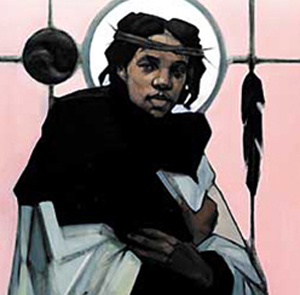
An androgynous Christ representing the ideal of the Church & humanity
Examining the Theology of Love of von Balthasar and its relationship to the Trinity, Guimarães explains von Balthasar's novel and completely unorthodox theories of an emptied Hell.
He also reveals a less admitted feature of the theologian's thinking. In fact, the beloved mentor of JPII and Benedict XVI sustains that this emptied Hell will be re-opened at the end of the world to receive the "integrists," that is, us traditionalists (Chap. VI § 47).
What Guimarães reveals is the implacable hatred of the progressivists for the Church Militant, so great that Guimarães suggests that their system should be called not the Theology of Love, but the Theology of Hatred.
As those who read this book will see, ultimately the Conciliar Church espouses not just a hatred for traditional Catholic dogma, but for the Triune God himself as the Church has always known Him to be.

Posted June 5, 2015
______________________
______________________



